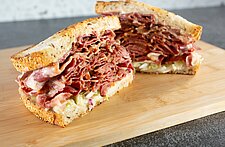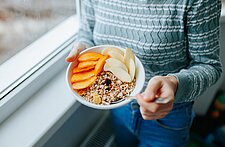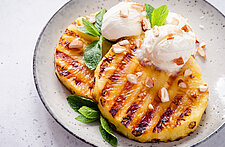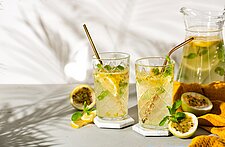Jose´ Olmeda Carles, chef and owner, opened Donde Jose´restaurant in 2014. Since then, it has become the “must go to” dining destination in Panama. When you plan a trip to Panama, make sure you make reservations early enough because the restaurant seats only sixteen guests. It’s well worth the advance planning because it features authentic Panamanian cuisine. Carles himself goes farm to table purchasing ingredients from local artisan farmers. Soon after its opening, Donde Jose´ became one of the highest ranked restaurants in Panama.
Emmanuel Laroche, Symrise’s head of Marketing and Consumer Insights, visited Donde Jose recently and wrote about it here on in-sight last week. Emmanuel and his team conducted the following interview to learn about Panama’s landmark dining spot.
Emmanuel Laroche: I am pleased to welcome you on behalf of Symrise’s team. I’d like to begin by asking where you grew up.
Jose Carles: Well, I grew up in Panama, was born and raised here. I had no plans to become a cook and tried different career paths. I was always in love with surfing, chasing waves so to speak. I spent some time in Ecuador, Costa Rica and Salvador but I was basically working here and there, nothing serious. Yes, I did work as a waiter at times, but I wasn’t thinking about becoming a chef until I was about 22 or 23. It was then that I decided I wanted to be serious about cooking. While I always cooked, it was a simple matter, amateur cooking, such as pastas and soups, nothing too advanced or showing too much technique.

EL: Can you describe your early training and what led you to a culinary career?
JC: After one year of studying in Panama, I started to think about cooking as a real career, but not in Panama because to be honest, at the time, it didn’t offer many opportunities. It’s very different now but in the past, it was hard to find a super professional kitchen. I did some research, looking to find a cool place to go, where I could get a good education and be able to study and work in a good environment. For several reasons, I ended up going to Australia. That is where I earned a Cordon Bleu diploma and began work at the very classy, upscale Icebergs Dining Room and Bar, the classic steakhouse/Mediterranean restaurant in Sydney where they served steak, pasta, risotto, and the typical favorites. It was not super challenging which was really what I was looking for so I moved on to Melbourne working at Attica, for Chef Ben Shewry. First, I worked as an intern and then I moved on to a full time job. I was there for a couple of months when one day out of nowhere, I began to think about Panamanian foods. Actually, the chef had started to ask me about Panamanian food and I realized that I didn’t really know too much about our food culture. It was the same for many other Panamanians. We knew about Chinese restaurants, Spanish, Italian and French restaurants but we underestimated Panamanian food. And so, I decided to return to Panama. I was very motivated to explore my country, excited to learn more about our country and it continues today. Each day I want to find out more about our ingredients, traditions and recipes that have been lost or forgotten. More and more, we are realizing that our food is much more interesting and diverse than we had thought it to be. Right now, we are at the stage where we are finally appreciating our potential – it’s a beautiful moment.
INFOGRAPHIC: Key Latin Flavors in the U.S.
EL: How do you describe the identity of Panamanian cuisine – its character and uniqueness - since it is a young country, with independence of about 100 years?
JC: Yes, we are a young country but we do have our traditions. There are some areas that demonstrate more pronounced tendencies toward tradition than others. While the entire country may not represent one unique, fully common identity, a significant portion of our country does have a shared identity. So while we don’t have a super Panamanian identity because we are young, there is the still the opportunity to add more to our identity, simply because we are young. I guess we have what you can call an immature identity. When you go to the Caribbean, you will see that there is a huge Afro Caribbean influence that relates well with other Caribbean countries and results commonality of recipes and ingredients.

EL: Can you name some dishes that Panama has in common with other Caribbean countries?
JC: Well, there is saus, which is pickled pig’s feet, a challenging dish that is regional but is also found in the U.S. and Jamaica. We also have a rondon, which is a soup that uses coconut water and conch fritters known as caracola. We use a lot of coconut, as well as spices and curries, not only found in Panama but in other Caribbean regions. We add a lot of our local ‘gush’ to Panamanian foods.
EL: Good. So can you tell us how your heritage influenced your cuisine today?
JC: In many ways, everything we do is influenced by our history and heritage. The word “Panama” in our native language actually means “diversity” and in Panama, our diversity is the great influence. We do have native Panamanians but when the Pacific Ocean was explored, it brought Spanish and Italians and Chinese and other Asians as well as Colombians and Brazilians. Afros and Americans migrated to our shores. This is called fusion by some but I call it evolution. I think Panama has evolved so that all that we do is influenced by foreign nations. Even street food has been influenced by other cultures. So, in a way we have all these influences in our cooking. This influence of other cultures has led to a loss in our own food culture identity and it is our duty to recapture it.

EL: How strongly do you feel connected to your personal heritage?
JC: Lately, more than ever. I have accepted the fact that our identity is mixed. A lot of people are confused when asked whether we are Spanish or Caribbean or Italian. I have an Italian passport and I have never been in Italy – how can you explain that? But, more than ever before, I am determined to explore my own country. I recognize that there is a reason for everything and I am feeling super connected to my country these days. Look, everything we do at our restaurant makes me feel super connected and I accept the fact that we are mixed.
CLICK HERE to view Culinary Chronicles on in-sight
EL: I am intrigued that your tasting menu features ten courses and three of them integrate ‘smoke’. What’s the importance of this ingredient in the foods you prepare?
JC: For me, smoke is one of two ingredients that are key – smoke and hot sauce. This may not be true for other Panamanians but it is for me. I’ve been exploring Panamanian culture even before I became a chef. I know the entire coast from my surfing days. I have family throughout the country. Because we are not a super large country, it’s relatively easy to get to know the whole of it. I am familiar with about 75 percent of the country. Many in our country still don’t have gas stoves. They have those old classic clay stoves that they fuel with wood getting that smoked effect. Some preserve the old traditions like killing the cow and smoking it throughout the day and then, eating it slowly and making a party of it. So many things are traditional, mostly on the Pacific side of our country, where people still cook over a fire with smoke, very slowly. Smoke is not generally spoken of but it is a present factor. We have many different smoking techniques that we use in our restaurant to create that authentic smoky flavor, stoking the fire, burying the ashes – the whole process. Cooking over fire very slowly is a tradition. The other dominant taste in Panamanian food is the hot sauce. You can find a version of homemade hot sauce in every traditional Panamanian restaurant. At our restaurant, we make a hot sauce that is based on a traditional family recipe – the kind of recipe that families don’t want to share.
EL: You mentioned previously that you have worked with different types of wood to create that smoky taste. What kind of woods do you use?
JC: Well, it isn’t just the wood that creates the smoky taste. There are many different ways to get that smoky effect. We use nance wood which is very stinky and weird but tastes delicious. Then we have manglais and mesquite. We also use wood from a very specific almond tree – not only using the branches but the leaves when they are dry. We also use the fruit from fruit trees. I also use coconut husks and various kinds of grasses, usually ones with hearty, thick leaves that we dehydrate. We are constantly experimenting with different woods.

EL: You serve a deconstructed version of an apple pie without using apple itself and there was a smoky element to the whipped cream on top...can you describe this creation?
JC: We use a vegetable called chayote. There are different kinds found in Panama, some of which grow in cactuses or on vines. It is a substitute for potato as well although it is not as starchy and it’s easy to add flavor to it. For the topping, we use a infusion that works the same way you would infuse oil with charcoal to create smoky flavor; you cover it and let it condense. We use nance, making it super hot, and adding a little red wine. We let it condense overnight and then we strain it and use it over ice cream. We play around with that quite a lot.
EL: Regarding hot sauces and everyone having their own recipe – is the chili pepper you use indigenous to Panama and different from the one used in Mexico?
JC: I am not certain if we’re using native chilies. I haven’t done the research on it. We use aichombo which is like the habanero. We follow the process of smoking it first, or dehydrating it. We use what is called pico di lauro – which translates into the beak of a bird – that is the most different chili that I have noted. It is super small, like the size of a dime. There is one I really like which is not spicy, (name?) In Panama, we don’t have as many chilies as they have in Mexico.
EL: What are some of the other typical ingredients that you use in Panamanian cooking?
JC: Well, culantro is traditionally used – not to be confused with cilantro. It is almost like a dandelinon, more like chicory with no curling edges, but with straight edges. It’s really the number one Panamanian herb. Then we have achiote, which is key in some Panamanian food such as stews. Corn is very important. We use it a lot in our soups. Plantains are also significant. The most important ingredient is probably coconut, including natural coconut milk. We use a lot of beets, the white ones and the purple ones that are used all over our country and increasing in popularity.

EL: When I visited your restaurant in Panama, it surprised me that there was no name at the entrance and that your menu appears on this little card which tells your guests are going to share some stories with them. You called them quentos. On the reverse side of the card, you have some clues...where did this idea come from?
JC: Our restaurant has been around for about three years and we are still evolving and experimenting, including our menu which we use to tell stories. At the beginning we had just one menu and then we realized that there were so many stories to tell and there was no better way to describe our country to visitors than by telling them stories. So now we create menus that highlight a tradition or an ingredient, with a story aims to be natural.
EL: Are you working on the next menu now?
JC: Yes, we are working on it right now, and it’s the most ambitious we have created so far. We are working with designers on novel containers, dishes and platters that hold the food we serve. We are using ingredients that are difficult to source. It’s taking longer than I wanted to change the menu but we should have it done within the next few months and it will also feature the stories we want to tell.
CLICK HERE to subscribe to the weekly in-sight newsletter
EL: You are effective in combining the traditional with modern cuisine. There is one dish which translates into ‘Where’s the milk?’ Can you describe it for us?
JC: We decided on a dinner menu that was inspired by breakfast foods – it was a challenge. One of the things I wanted to do was to make milk the ‘star’. I didn’t want to simply add milk to a recipe. I saw things done such as juva with soy milk and I saw milk heated and boiled and gleaning off the skin at the top and using it. At Numa Restaurant I saw a taco with milk so I learned how to do it, but I wanted to make it super crispy not soft like Numa made it. I tried looking for a recipe for months that would do that. I also tried different techniques relying on different kinds of dehydration – air drying or in a pan or using the microwave. It was taking about six different processes to get a cylinder of crispy milk. The texture we achieved makes it necessary to chew it longer and the last taste you experience is the milk – it’s a very special thing we have on the menu right now and it’s all about milk.

EL: Can you disclose a new item on your menu that is especially novel and appealing?
JC: One of the new ingredients that we are happy about using is seaweed – traditionally in the Caribbean it is white seaweed that is used. There’s something called Ice in Glass which is rather strange – heavy and sweet and more like a dessert. It is associated as giving energy or fertility for men, a natural Viagra. Its tradition is Afro Caribbean. After experimentation with different processes, we developed something that’s almost like a pretzel, crispy but made with 100 percent seaweed. We are also currently working with sea snails and local sea urchins which is something no one else is serving or using in Panama. I am also working with rough oysters and canuch, a native plant. Depending on how it grows, it has some sprouts about two inches and looks like small trees with stems that resemble asparagus. It tastes like peanuts – it is crazy good. We are also playing with edible flowers and wild plants.
EL: What else inspires you in addition to the ingredient and/or its source?
JC: From menu to menu I am always looking for something that is more challenging. So far when we have gotten good results with every challenge our team at the restaurant has tried to overcome. We look for amazing results so that when people from around come to us, knowing that they are at the only place in the world where they will find something that has never been done before – or, if it has been done before, done in a way that you would never expect it. In our current menu, we have been working extremely hard to include lots of greens and vegetables. The goal is to create light and healthy menus that are, at the same time, very satisfying. To create a new menu, I also go to random places, searching for new ingredients with no predetermination about what I want or expect to find. When I find something new, I record it for the next menu so it’s an ongoing search for what is new and different.
EL: In this context, tell us about the Gastro Lab you have created?
JC: Well, it’s a place of evolution, a space that is literally dedicated to study what we’ve found and to concentrate on making things taste homemade. We examine and test ingredients and processes. It’s a way of having an ongoing resource so that when we want to change the menu – there is something already there that we can draw from. Later on, when we can afford it, we will serve as a base for what defines our identity. I am convinced that food allows you to do that. We want to feature an ingredient and provide a vast number – say 30 things - that can be done with that ingredient.
EL: Will the Food Lab be a place that other chefs can come to?
JC: We’re open to other ideas, but basically, it is something very personal. If it’s something that we want to put our name on it, we will do that. We want to share. I don’t care if it’s done by someone else. We want to open because we are experts on some things and want to interact with different people in different fields and share our ideas. I see us as instructors. I don’t want input from other chefs yet if they have special knowledge such as fermentation or other technical matters, I welcome their sharing this kind of information.
EL: Is there anything else you can share with us?
JC: Well, Panama is not well known to many and nor is our cuisine but it’s happening now. I can safely predict that once more people start to experience our culture and our food, Panama will be seen as one of the coolest places in the world.
EL: Thanks very much, Chef, it has been a pleasure to learn more about Panama and its delicious cuisine which I have experienced firsthand.
Stay tuned to in-sight for more chef interviews and culinary inspiration.




